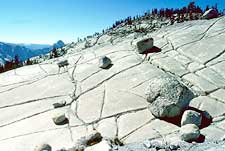Established 1890
 Rocky Tioga Road, Yosemite National Park
Rocky Tioga Road, Yosemite National Park 761,266 Acres
QUICK—TRY TO THINK of a national park whose icons are more familiar than Yosemite’s masterpieces of rock and water: Half Dome, El Capitan, Tuolumne Meadows, Horsetail Fall. No place comes close to this park’s abundant glacier-polished granite, a veritable shrine for ROCK CLIMBING. For those with the aid-climbing skills, the tip of Lost Arrow Spire is an electrifying place to rise above the fray, quite literally, with outrageous views of Half Dome and Yosemite Valley. The spire is a tapering finger of rock that parallels the main Yosemite Falls Wall, with an adrenalizing twist: Although you climb only 250 feet on the spire, there’s some 1,500 feet between you and the valley floor below, more than enough to get you mumbling incoherently about your own mortality. Lost Arrow also demands some intermediate rope tricks: For one, it starts with a rappel from the valley rim to the notch between wall and spire; since that drop is longer than a climbing rope, the rappel entails tying two ropes together and then passing a knot around your belay device. In two pitches you’ll get to the spire’s small, slanting summit. You return to the rim (where you started) by way of a Tyrolean traverse, which means scuttling horizontally along parallel ropes threaded through permanent bolts—again, with maximum air below you. Complete the circle, and you’ll feel like an astronaut coming back to earth. By the numbers the climb is Grade III, 5.7, C.2; if any of that sounds like quantum physics, you’re not yet ready for Lost Arrow. (Instead, scamper up classic but less serious climbs like nearby 5.8 Bishop Terraces.) There are two ways to approach the spire; we suggest making it a weekend trip either way, camping off-trail the nights before and after the climb. If you have ample sweat to spill, hike the four steep miles from the Valley on Yosemite Falls Trail via Yosemite Point. (Payoff: at 1,430 feet, upper Yosemite Falls makes spectacular trail company.) If you’d like a gentler hike in, take the rolling seven-mile Indian Creek Trail, located east of Porcupine Flat. For obsessively thorough details of Yosemite climbing routes and great climbing history, check out climber Chris McNamara’s Web site at . For lessons or guided climbs, contact Yosemite Mountaineering School, 209-372-8435.
WHEN TO GO: In late April and early May you assume the risk of intermittent crummy weather in exchange for smaller crowds and temperatures much more tolerable than summer’s 90-degree highs; spring is also peak waterfall season. Come fall, even as early as late September, backcountry trekkers feel like they’ve got the place to themselves.
ANNUAL VISITORS: 3.5 million. (High: July, 572,440. Low: January, 97,985.)
MORE CHOICE ADVENTURE: Some of Yosemite’s least-known HIKES offer some of the sweetest payoffs. Try a 14-mile overnighter from Tenaya Lake through fields of wildflowers to the top of Clouds Rest—more than 1,000 feet higher than Half Dome, with a better view from the valley rim and far fewer hikers on the trail. Do it on your own or call Yosemite Guides, which leads guided day trips and overnights throughout the park, starting at $65 per person (877-425-3366, ). HEADLAMP READING: The Complete Guidebook to Yosemite National Park, by Steven Medley; El Capitan: Historic Feats and Radical Routes, by Daniel Duane.
LOCAL SPECIALTY: Twenty-five miles southwest of Yosemite Valley on Highway 140 is the Yosemite Bug Hostel, with Guinness on tap and great eats for about half what you’d pay at the park’s showpiece Ahwahnee Hotel.
INSIDE SCOOP: In 1998, a Yosemite crime wave of sorts hit an all-time high, when property damage exceeded $659,000 and more than 1,300 automobiles were broken into—all by bears. Since then, the Park Service has reported a drastic decrease in ursine break-ins, thanks to an array of tactics that includes stiff fines for park visitors who leave food in their cars (climbers get warnings for leaving gum wrappers in their backseats) and rangers “hazing” problem bears with loud noises and rubber bullets.
PARK HEADQUARTERS: 209-372-0200,


